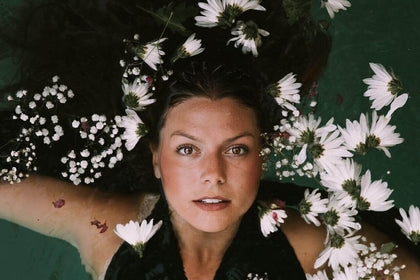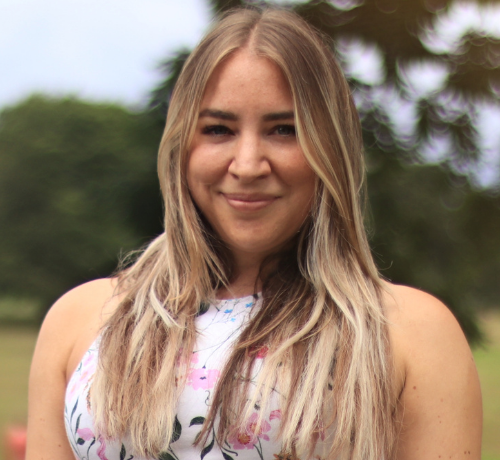What do Kourtney Kardashian, Alyson Hannigan, Leonardo DiCaprio and Marilyn Monroe all have in common? They all have a widow's peak, a little V-shape at the center of their hairline. A fair amount of lore surrounds the topic of the spookily named window's peak, like whether it's a genetic trait or signals a receding hairline. How do you tell fact from fiction?
Whether you're curious about where your widow's peak hairline came from, are worried it's triggering hair loss, or want to know how to master styling it, keep reading to discover all you need to know. Plus, discover the vegan hair serums that will keep every hairstyle and hairline looking full and luscious.
What Is a Widow's Peak?
A widow's peak hairline is very prominent for some and less so for others. The V-shaped hairline lands in the center of the forehead, with the rest moving back toward the temples. Dr. Hari Kiran Cheruki, a certified dermatologist, hair transplant expert and cosmetic surgeon, explained, "It can range from subtle indentations to more prominent points. It is typically genetic, though it can sometimes occur due to age or certain medical conditions."
The term 'widow's peak' doesn't come from a horror movie or something with creepy connotations. Instead, it originated in 18th-century England and referred to the black triangular hood (which had a point at the middle of the forehead) a wife would wear after her husband had died.
Many people are born with a widow's peak, but it can develop in someone's early twenties or later in life as a sign of a receding hairline or thinning hair. A prominent peak can develop as a receding hairline sets in, leaving a V-shaped hairline and the impression of a widow's peak. But it's not necessarily an early sign of thinning hair or baldness.
What Causes a Widow's Peak?
In the same way that a cleft chin or naturally curly hair is a genetic trait, the V-shaped hairline of a widow's peak commonly runs in families. Sometimes it's a slight V in an otherwise straight hairline, and sometimes the hairline has a distinctive shape.
Scientists have been unable to define the genetic traits of a widow's peak hairline or how someone can inherit the trait. It is believed to be caused by multiple genes, and it can be hard to predict whether someone will or won't develop the hairline. But the research is minimal, and it could be caused by one single dominant gene.
A widow's peak hairline has been associated with a few genetic conditions, such as:
- Donnai-Barrow syndrome (DBS) — mutations in the LRP2 gene cause this rare genetic condition. It can cause irregular features of the ears, nose and eyes.
- Aarskog syndrome — short stature and other signs of abnormal development characterize this rare genetic condition. It's associated with the FGD1 gene on the X chromosome.
- Frononasal dysplasia — this very rare condition involves unusual development of the face and head. Several versions of the condition are known to be caused by mutations in the ALX 3, ALX4 and ALX1 genes.
If you have a widow's peak, you might feel different from others, but many people sport the look with pride, and it's pretty common. A study involving 1000 university students found that 36.8% of them (men and women) presented with a widow's peak.
Widow's Peak vs. Thinning Hair
Many people confuse widow's peaks with receding hairlines because they can look quite similar. Hair growth halts around the temples in male- or female-pattern hair loss, leaving a telltale M-shape behind. And because men often have shorter hair, anything other than a straight hairline can stand out.
With a widow's peak, the thickest part of your hair is in the center of your forehead and thins out around the temples. With a receding hairline, your entire hairline can be impacted. When struggling with hair loss, you might also notice thinning behind the hairline, whereas with a widow's peak, the hair doesn't thin out elsewhere on the scalp.
"Hair loss is often associated with thinning on top of the head as well as patchy bald spots," confirmed Cheruki. "These symptoms are usually more apparent when running your hands through the hair, and can occur with age or due to medical conditions. With a widow's peak, however, there is no thinning of the hair but, instead, an indentation that forms in the middle of the forehead. This is usually noticeable from the front and can be seen even with long hair. In some cases, the indentation may become more pronounced over time due to aging or medical conditions."
It's natural for people to lose between 50 and 100 strands of hair a day, but if you're noticing substantial hair loss and hair growth has become an issue, it could be time to talk to a professional. Hair shedding can be an indication of other medical issues. Topical treatments and vitamin supplements will help keep delicate strands in the best condition — and you don't have wait to employ healthy hair tactics just when hair loss hits. By taking a preventative approach, you can keep your hairline looking full and healthy and your hair long and luscious long-term.
A Natural Serum to Support Thicker Looking Hair
GRO Hair Serum is a bestselling all-natural formula that's non-greasy and suitable for both men and women. The plant-based serum is leave users with thicker, fuller-looking hair in as soon as 90 days.
#include-related-slider#
How To Style
Whether you love your widow's peak and want to embrace it fully, or it frustrates you and you want to hide it, it's all a matter of personal preference.
The comb-Over
For men, the classic comb-over is a practical hairstyle that requires minimal styling. Comb the hair to one side to call attention to the natural texture of your strands.
An Undercut
A great look for both men and women, this edgy hairstyle will plump up the look of any thin strands around the front by making things even thinner around the back. It's also a great way to remove the focus from your hairline.
The Slick Bun
A widow's peak can be incredibly attractive, so show it off with a chic slick bun. Pull the individual hairs back in a pony and use gentle bamboo hair ties to hold the look in place. Add hair gel for an edgy, wet look.
Play With Your parting
A widow's peak is incredibly versatile because you can naturally part your hair in several ways. Whether you want a side parting or a center one, you can quickly achieve the look, leaving you endless ways to experiment with your hair.
Remove Unwanted Hair
If you hate your widow's peak, you could remove unwanted hair with an at-home waxing kit or a round of laser hair removal. Some also pluck out individual hairs if their widow's peak is less prominent, but be careful not to give yourself a crooked hairline. If in doubt, always discuss with a professional for guidance.
Grow Bangs
Growing bangs can help soften your hairline and de-emphasize your widow's peak. If you struggle with a fluffy cowlick, tame your tresses with a styling foam that keeps your scalp nourished, and use a gentle hair spray to hold.
Peak Their Interest
A widow's peak hairline can be beautiful and distinctive. Some prefer to downplay the look, while others want to show it off. It can look similar to a receding hairline, but you only need to worry if you suddenly notice that you're losing a lot of hair. If you are living with hair loss, rather than rely on a quick fix, use an all-natural serum that is scientifically proven to boost your locks without the need for toxic ingredients. And if you're concerned, always check in with a medical professional.
More From VEGAMOUR
- SHOP: Shea Whitney's VEGAMOUR Picks
- 8 Reasons for Hair Shedding
- How to Use Leave-In Conditioner for Best Results
Photo credit: averie woodard/Unsplash
Back



















